Top Five Shipwrecks of Underwater Photographer Steve Jones
He’s photographed more wrecks than we can count. After several articles for DIVER, we gave the renowned UK photographer the challenge of finding his favourite five.
Words and Photography By Steve Jones
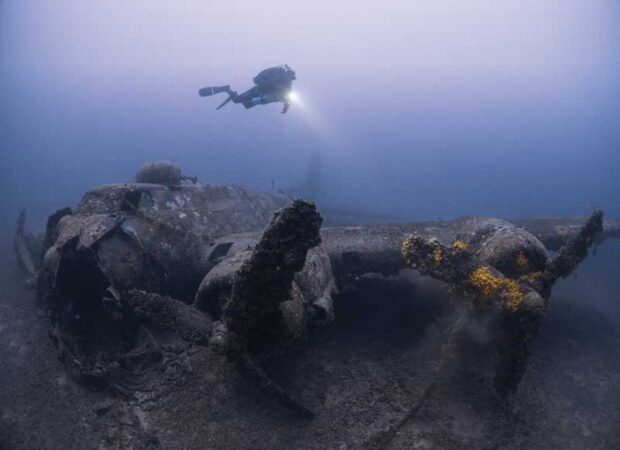
I’ve visited my fair share of wrecks over the years, so shortlisting five that have left the biggest impression on me required some serious consideration! It’s no coincidence that all that made the final cut were lost during wartime, since wreck diving fulfils both my passion for history as well as exploration: understanding the events that led to destruction of that vessel, often in horrendous circumstances, means that the dive is all the more meaningful.
Last flight
Ultimately, choosing the most endearing wreck of all was surprisingly easy: an intact B17-G Flying Fortress lying in deep waters off the coast of Croatia. It’s not the remarkable condition and perfect poise of this wreck of the iconic World War II US bomber that makes it so special, nor the sheer thrill of dropping over 230 feet (70m) onto this mighty aircraft, but the personal story that unfolded afterwards. Freshly commissioned, this particular B17 took off from Italy on its maiden combat mission on November 6, 1944 but encountered fierce ant-aircraft fire over its target, a railway junction in Slovenia. Flak struck the aircraft, mortally wounding co-pilot Ernest Vienneau and with two failed engines the stricken bomber limped towards the nearest friendly base on the island of Vis: a haven for damaged aircraft unable to make the flight back to their bases. During that nerve-wracking flight, a third engine failed and, as they were on their final approach, the last engine cut out, leaving the fate of the crew firmly in the hands of pilot Irving Emerson—who made a skilled water landing, allowing the survivors to escape in dinghies as the wreck descended to the depths with Lieutenant Vienneau’s lifeless body still aboard. This wreck is very much a war grave.
Much excitement was generated by the discovery of this wreck by Slovenian divers in 2001 and it didn’t take long for Croatian historian Danijel Frka to piece together its full history, but a piece of the puzzle remained unsolved: no contact had been possible with the family of the deceased co-pilot to inform them of the wreck’s discovery. That all changed after my image of this aircraft was commended in a recent Underwater Photographer of the Year. Soon the competition winners were appearing around the world, including the US press, and a reader recognised the co-pilot’s unusual name in my caption. Acting on a hunch, they sent the story to a family friend, Robert Vienneau. Incredibly, Robert was Ernest’s nephew and once he got in contact, I was able to connect the family to Danijel, who could share his knowledge and who had actually met some of the surviving crew, who were with Ernest to the last. A connection of huge importance had been made for the family; until that time the Vienneaus had only known that Ernest was missing in action. I have been in regular contact with them ever since and gained a wonderful insight into the life of this young man, whose life was cut short at the age of only 25. It’s a particularly poignant connection for me, for my own grandfather, whom I never met, flew in RAF Bomber command; through my own research I now have a greater appreciation of what these crews went through on deployments where hazards were huge and life expectancy painfully short.
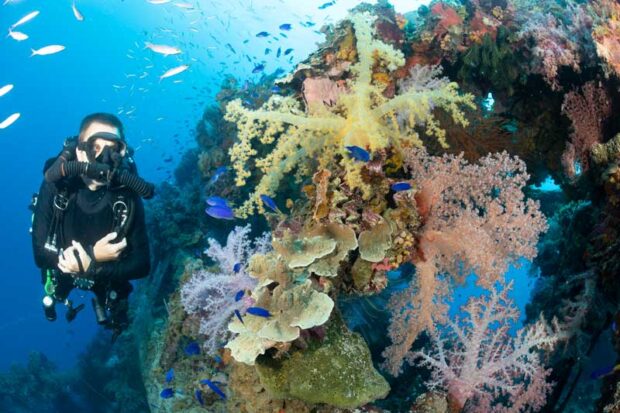
new home. Photo: Steve Jones
Ghostships
In this list there is a destination that was sure to make the cut, for the legacy left by the US Navy’s devastating attack on this World War II Japanese base has created arguably the world’s best wreck diving destination: Truk Lagoon.
A few days into a trip and first-time visitors will begin to appreciate the enormity of destruction unleashed on the 17th and 18th February 1944. No less than nine US Aircraft Carriers, capable of putting 500 aircraft into the air, were involved in that initial 2-day attack, sinking over 45 Japanese ships—over 200,000 tons of shipping! Thousands of Japanese lost their lives and the base infrastructure was heavily damaged, with over 270 Japanese aircraft destroyed. A follow-up visit on 29-30th April caused even more destruction, leading to Japan demobilising the base as the Allies tightened the noose around their adversary.
The challenge for me was choosing which wreck from this incredible place was going to come out as favourite. Would it be the huge, accessible Fujikawa Maru, whose holds are filled Zero fighters, or the tech divers’ favourite, the San
Francisco Maru, which still contains so much cargo that it’s known as the million-dollar wreck? Ask any number of wreck divers which is their favourite here, and you’ll simply get as many different answers. For me it is the Shinkoku
Maru that holds that special place in my memories. With the deepest part of the wreck at 130ft (40m) and all the interesting areas at a much shallower depth, this wreck is very much accessible to recreational divers, although experienced divers will almost certainly want to explore the deeper engine room areas which lie at around 100+ feet (30+m) and are bathed in surreal emerald light streaming through the hatches. Exiting this spot through the adjoining crew quarters will force your eyes to adjust from the gloom to bright, vivid colour. Like many of the shallower wrecks in Truk Lagoon, its sunlit upper levels have been transformed into a glorious living reef, where coral grows in abundance and reef fish swarm down this former tanker’s entire 500ft (150m) length. The ship’s hospital is still there, complete with bathtub, surgeons’ tables, and tools, while the bridge is the prettiest I’ve seen on any wreck, complete with two intact telegraphs, and decorated with pink, white and orange soft corals. You will need countless dives on this wreck to see it all.
Casualties of war
The shipping lanes near Malin Head were strategically vital and, as the Battle of the Atlantic raged during World War II, convoys between the UK, Canada, and the USA found themselves under co-ordinated attacks from Hitler’s U-boats as the latter attempted to strangle the supply lines of Allied forces in Europe. On September 8th, 1944, as over 100 ships in convoy HX-305 neared the Irish coast, U-482 skilfully weaved amongst the convoy and fired a single torpedo into the SS Empire Heritage, a former whaler carrying 16,000 tons of fuel. A catastrophic explosion sank the ship so quickly that no distress signals were sent. But for the survivors, the ordeal was not over. Just over 30 minutes later their rescue vessel Pinto was also struck, possibly having not been identified as a rescue ship. Pinto was gone in 90 seconds, and the two sinkings caused huge loss of life.
As you descend onto the aftermath of this catastrophe, a surprising scene gradually unfolds, for this wreck was carrying nearly 2000 tons of battlefield equipment! Sherman tanks lie entangled with trucks like discarded children’s toys, spread across the wreck and seabed as far as the eye can see. As you stare at one tank you may realize that it sits upon another, with several more soon revealing themselves beneath. Some vehicles are upright and perfectly intact, whilst others are still racked neatly in the holds in remarkably good condition. Years of wave action have smashed in the superstructure of this enormous, 15,702 ton wreck, which now rises very little above the gravel seabed at 225 feet (68m). At this depth it’s not realistically possible to explore such a sizeable ship in one dive, so it’s best to pick your area and focus on it. Near the aft section of the ship are six huge boilers arranged in neat rows of three, while in the forward areas the holds teem with fish life. The Empire Heritage is one of the largest ships sunk in World War II and an absolutely exhilarating dive.
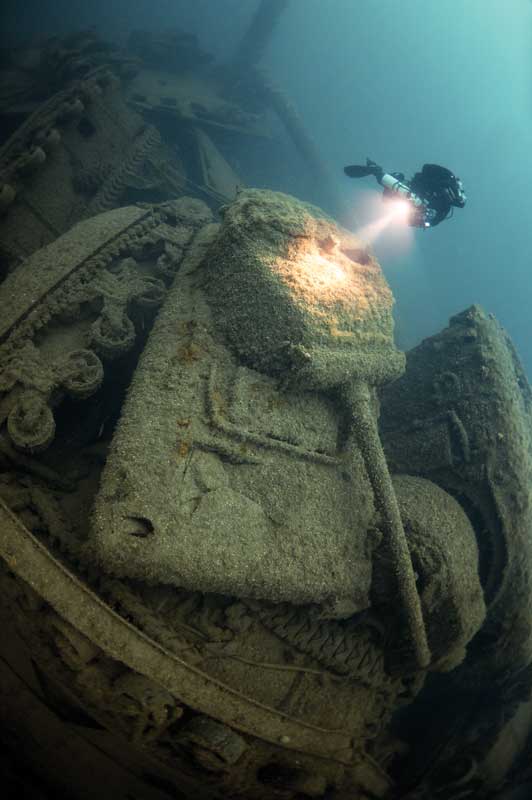
Endearingly charming
Now to the warmer and endearingly charming Mediterranean destination of Malta. This place has a quiet ambience that belies a fascinating and often violent history, for its strategically significant position has led to a fair share of conflict throughout the ages. In World War II, it earned the unwelcome label of one of the most bombed locations in history due to its importance to the Allies as a staging base for intercepting German and Italian supply lines into North Africa. Besieged during the early stages of the war, ferocious air battles erupted as the Allies desperately resisted a seemingly overwhelming enemy onslaught. The population starved whilst outnumbered defenders ran short of ammunition and fuel, so the key to Malta’s survival lay in getting enough supplies through. Convoys became that vital supply lifeline but were under constant attack, which continued even if they made it to harbour. The legacy of these efforts can be found in the blue depths that surround this tranquil island, with more wrecks being discovered every year as technical divers explore previously hidden areas. It was in March 1942, with the siege at a peak, that convoy MW10 steamed toward Malta with desperately needed supplies. After being delayed enroute due to ship-to-ship combat, the convoy then came under air attack as they approached their destination. In the chaos of battle, the British vessel HMS Southwold attempted to tow a stricken convoy ship away from a minefield, yet itself hit a mine that killed five crew. Whilst being towed, the hull of this destroyer then split in two, sending her to the bottom in two halves that now make separate dives as they lie approximately 1000 feet (300m) apart. The bow lies completely on its starboard side in 225 feet (68m) of water. As you head forward, this warship quickly becomes recognisable with the bridge and forward areas still intact with the main guns attached. The stern lies slightly deeper, upright at 236 feet (72m) and is in remarkably good condition. The rear guns are still angled upwards as if ready to fire, reminding us that this ship was at battle stations when it went down. Neatly arranged depth charges can be seen in their racks and, amazingly, the nameplate of the ship is still there. Taking artefacts from any wrecks in Malta is strictly forbidden, evidenced by the amount of poignant personal items that still lie on their wrecks—an enlightened policy that preserves Malta’s underwater heritage as a museum for future generations of divers.
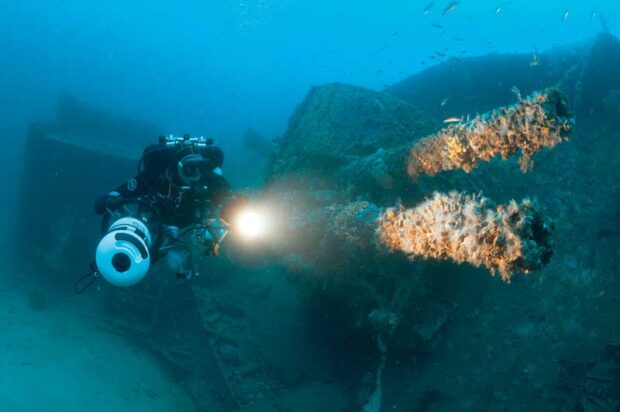
Silent guns
The final wreck in this whirlwind tour of my top five, can be found in the cold green waters of the North Atlantic near the northern tip of Scotland. It was here on 21st June 1919, the Imperial German Navy sunk nearly an entire battlefleet in one fateful afternoon. Startlingly, that fleet was their own and their actions unwittingly created one of the world’s finest wreck diving destinations.
Scapa Flow, a strategically important natural harbour in the heart of the Orkney Islands, has seen its fair share of tragedy, including the World War II torpedoing of HMS Royal Oak, when 833 sailors lost their lives. However, it was in the aftermath of World War I that events transformed this harbour into the wreck diving destination it is today. Following the November 1918 Armistice, the ships of the Kaiserliche Marine were interned here, yet final peace proved elusive. Fearful the British would seize his fleet, the German commander gave the order to scuttle. Meticulous preparation assured success; by late afternoon on that momentous day, where there was once a battlefleet there was now floating debris as fifty-two ships lay on the bottom.
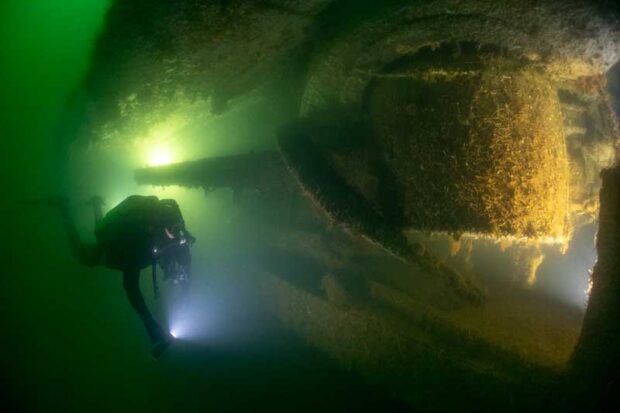
Following one of the world’s greatest salvage efforts in the 1920’s and 30’s, there are seven warships still there today. The four cruisers are considered by many to be more varied and interesting dives; however, if you want sheer awe-inspiring spectacle, it is on the three colossal super-dreadnoughts that you’ll find it—and there is no greater one that the SMS Markgraf, the most intact battleship in Scapa Flow. As you descend into the emerald void, the immense hull of this upside-down, 25,000 ton behemoth appears first, covered in anemone growth and massive, beyond anything most divers expect! After hovering over this metal desert, you can head over the side into the beckoning darkness, dropping a further 65 feet (20m) into a tangle of twisted metal, where powerful lamps will pick out familiar shapes in this upside-down world. All the battleships rolled as they sank, pulled over by the weight of thick deck armour and heavy weaponry. Eventually the distinct outline of a gun barrel emerges, menacing, as if it were sailing out of surface fog, and suddenly this ship reveals itself for what it was—one of the most powerful warships ever created at the time of its sinking. The starboard side, propped up by the superstructure, is where the most interest lies; here you will find casemate guns, reminding us that this ship bristled with weaponry that could take on any opponent. There were 14 of these smaller 6 inch (15cm) guns, used primarily for defence; the offence came from the ten main guns, which could hurl huge shells onto targets nine miles (15km) away. You can’t see the iconic main guns of the Markgraf, but a short trip to her nearby sistership the Kronprinz Wilhelm will give a great view of these monstrous weapons of destruction. The is simply no finer destination than here to see such a variety of World War I era warships.
For more diving information, visit:
B-17G, Croatia: Manta Diving Centre www.crodive.info
Truk Lagoon: M/Y Truk Master www.masterliveaboards.com
Scapa Flow: Halton Charters: www.mvhalton.co.uk
Malin Head: Jack Ingle: www.jackingle.co.uk
Malta: Techwise www.techwise.com.mt







